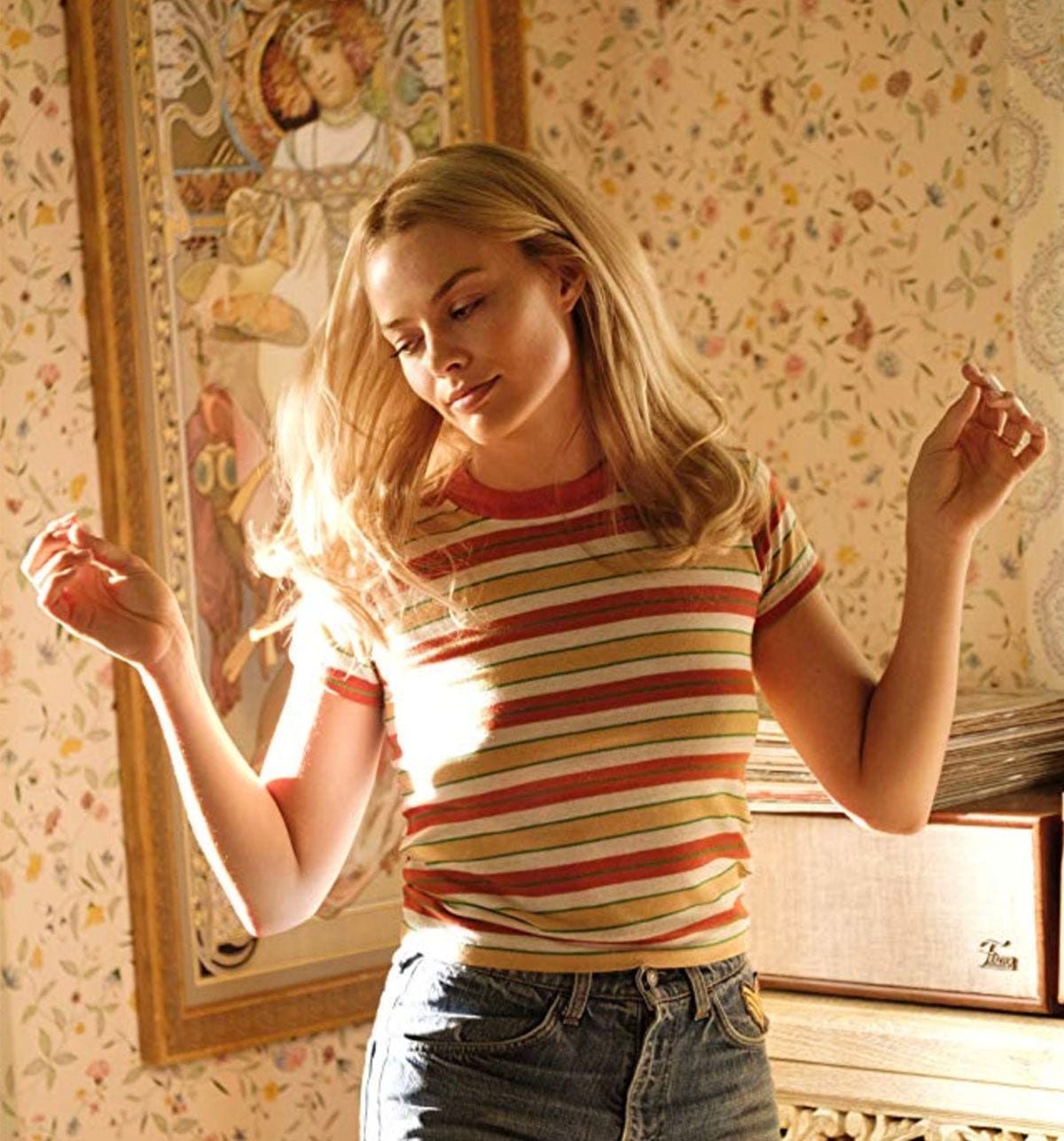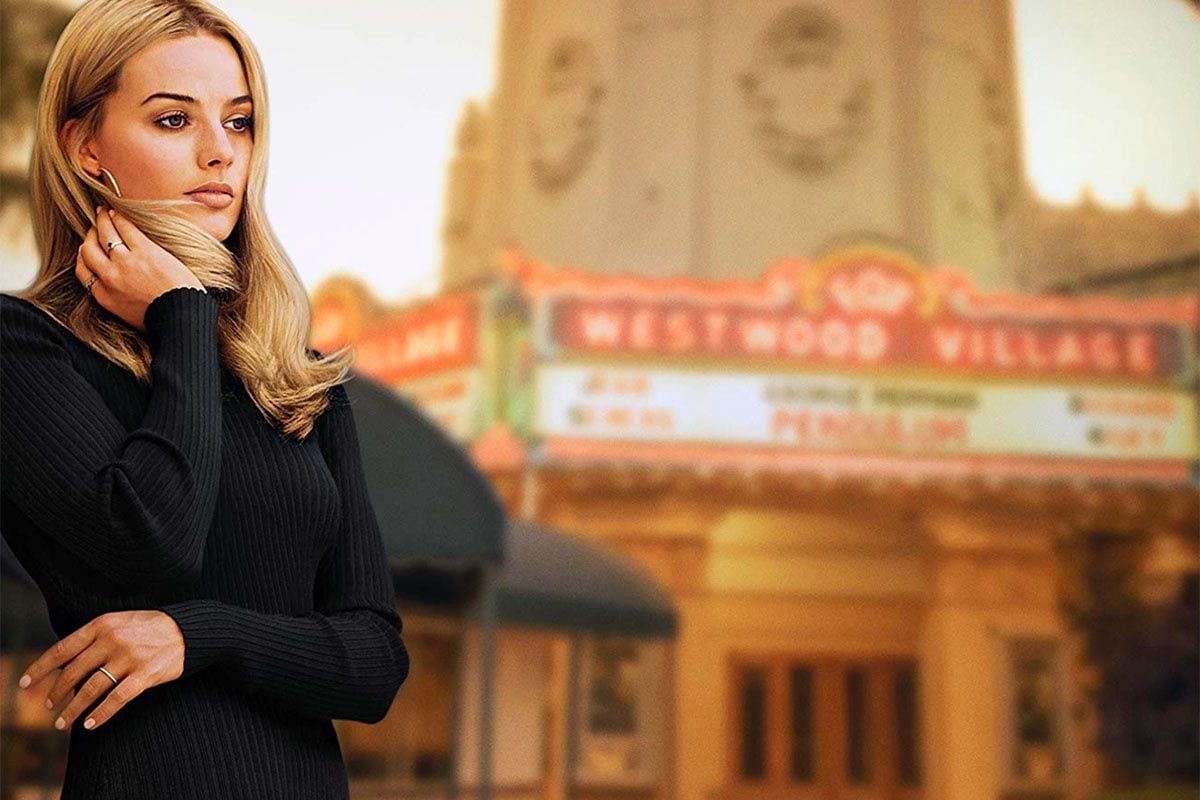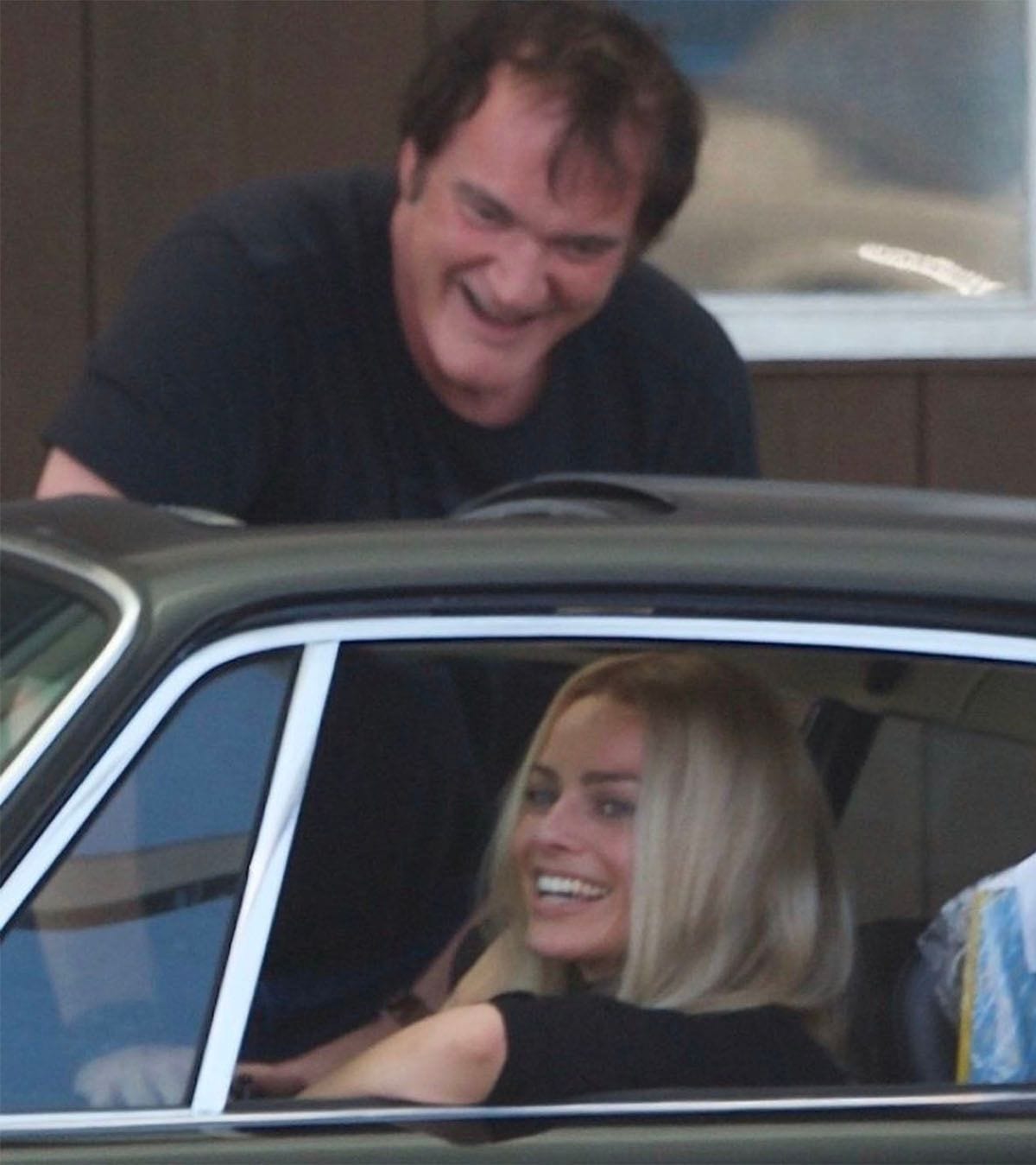
From the beginning of Quentin Tarantino‘s career in the early 1990s, one central feature of his filmmaking approach has been his adroitness in popular cultural reference and remix. At times, popular and critical reactions to this particular talent have been accusatory. One memorable charge (which I recall being debated on the school bus) was an opinion of some viewers and critics that Tarantino should have been more transparent about how liberally he borrowed from 1987 Ringo Lam film City on Fire for his breakthrough film, Reservoir Dogs (1992). Where was the line, some wondered, between reference and rip-off? Had Tarantino crossed it?
Overall, though, discussions about Tarantino’s creative referentiality have been celebratory. Before Pulp Fiction was released in 1994, Sight and Sound spotlighted that film as the most notable example of early-to-mid ’90s films indebted to pulp fiction as a source for plot and style. During the decades and films that followed, the acceptance of Tarantino as a remixer of existing works has produced a popular parallel activity of reference-spotting and cataloguing, such as Vulture‘s 2015 feature, “Quentin Tarantino: The Complete Syllabus of His Influences and References”.
The nature and usefulness of this attention is debatable, especially within post-modernism’s conflicted and confusing relationship to history. Yet at least two fruitful ideas have emerged from seeing these recurring reviews of referentiality within Tarantino’s work. One is the possibility that Tarantino would someday look to historical events for inspiration beyond his collection of fictional sources. The second idea is that Tarantino was probably destined to return to his own works for inspiration as his filmography wound down to the finite number of ten feature films he pledged to create.
In this way, Tarantino’s ninth film, Once Upon a Time…in Hollywood is entirely foreseeable. Here is a film that goes beyond the filmmaker’s expected approach to lifting from cinema history to prop up his original stories. Once Upon a Time…in Hollywood is more reflexive; an alternately rose- and deep red-colored view of that history, or at least of certain real icons and events of the period. As has been discussed in PopMatters and elsewhere, the ethical issues of Tarantino’s historical revisionism are present in this film as they were in Inglourious Basterds (2009) and Django Unchained (2012).

Film Strip by joseph_alban (Pixabay License / Pixabay)
Once Upon a Time…in Hollywood is a film that seizes upon a few days in 1969 of a Hollywood in transition to rejigger the events and meanings of those waning days into an overlong episodic series of Hollywood product recreations. Contexts for scenes include making and watching television shows, feature films, advertisements, and behind-the-scenes interviews. This is Tarantino’s first movie about moviemaking. He contextualizes the main plot within a docu-fairy tale variation on the Manson cult murder of actress Sharon Tate (Margot Robbie), her unborn baby, and four others present at 10050 Cielo Drive in Los Angeles, California in August 1969.
The way in which Tarantino reimagines the historical circumstances of the Tate murders provides an opportunity to discuss the ethical obligations a storyteller should have while rewriting history, especially within a work that combines nonfiction with fiction. But the most egregious missteps of Once Upon a Time…in Hollywood involve that other branch of Tarantino’s evolving body of references, which are the contents and circumstances of his own career and cinematic output. Though many of his works share certain recurring shot subjects, compositions, soundtrack styles, and editing rhythms, Once Upon a Time…in Hollywood includes content that seems designed to show how unrepentant Tarantino is regarding past errors and misdeeds, offscreen and onscreen.
For example, there is the slight, innocuous characterization of Roman Polanski (Rafal Zawierucha), the filmmaker who was married to Sharon Tate at the time of the murders. Polanski’s current wife Emmanuelle Seigner has called out Tarantino and the film’s studio for profiting from her husband’s story while simultaneously Hollywood has “made him a pariah.” But Polanski is a convicted child rapist who fled the United States before his sentencing in 1978, so Seigner’s accusation that Hollywood has ostracized her husband is completely without merit.
In fact, it is Tarantino’s perspective on Polanski, which he shared in an interview with Howard Stern in 2003, that illustrates how welcome Polanski remains in the greater film industry. Tarantino said of Polanski’s crime: “He didn’t rape a 13-year-old. It was statutory rape… That’s not quite the same thing… He had sex with a, with a minor, alright? That’s not rape.” In the same interview, he stated that the victim “wanted to have it.” Only in February 2018, when audio of that interview surfaced again online, did Tarantino apologize to the victim for his comments.
Yet it is difficult to reconcile the controversy and apology concerning such statements with the characterization of Polanski within Once Upon a Time…in Hollywood. As Tarantino’s film dials back the years to a pivotal event in Polanski’s life and then alters the real outcomes of that event, Once Upon a Time…in Hollywood offers Polanski another timeline, another possibly less troubled life in which he might have made different decisions or escaped scrutiny/judgment.

(IMDB)
In addition to this speculation over what might have been, viewers who watch Once Upon a Time…in Hollywood without knowledge of Polanski’s child rape conviction and multiple allegations of sexual assault might remain ignorant of the real man behind the figure in this good-times Tarantino fairy tale. The characterization of Polanski in Tarantino’s film seems like evidence of ongoing support for the mythic, “innocent” Polanski rather than any sort of acknowledgement that the myth is a lie. Polanski is a minor figure in Tarantino’s film, but the choices Tarantino makes to revive him absolve Polanski from his unresolved transgressions.
More troubling is the way in which Tarantino shows off his fixation with endangering women in cars. Another recently revealed past misdeed was Tarantino’s insistence that Kill Bill (2003–2004) star Uma Thurman drive a vehicle on camera, against her will, which resulted in a car accident and subsequent cover-up by Miramax, Harvey Weinstein, and other men involved with Kill Bill. In February 2018, the New York Times published Thurman’s comments about the incident to Maureen Dowd, in a feature that also detailed attacks from Harvey Weinstein Thurman endured during her career. (“Quentin Tarantino Responds to Uma Thurman as Polanski Comments Resurface”, 6 Feb 2018.)
In the article, Thurman recalls the coercion that her longtime collaborator Tarantino used to persuade her to perform the driving stunt, on camera, in a convertible:
“Quentin came in my trailer and didn’t like to hear no, like any director,” she says. “He was furious because I’d cost them a lot of time. But I was scared. He said: ‘I promise you the car is fine. It’s a straight piece of road.'” He persuaded her to do it, and instructed: “‘Hit 40 miles per hour or your hair won’t blow the right way and I’ll make you do it again.’ But that was a deathbox that I was in.”
Thurman’s account must be read in full to understand the extent of her injuries, her director’s irresponsibility, and the corruption of the cover-up that kept Thurman from seeing footage of the accident for 15 years. On Instagram, Thurman described “the circumstances of this event” as “negligent to the point of criminality.” Again, as with the circulation of the Polanski comments audio, Tarantino reacted by apologizing and trying to adjust the narrative in his statements to reporters. In fact, the two apologies occurred in such quick succession that there were several articles written in early February 2018 that collected the various scandals and apologies, summarizing his “tour of contrition” as Yohana Desta labeled it in Vanity Fair. (Quentin Tarantino Is Really Sorry for Defending Roman Polanski”, 8 Feb 2018.)
One detail about the Thurman incident that is consistent in both her account and Tarantino’s account is the director’s prioritization of a particular visual component that he says necessitated Thurman driving the car herself, rather than utilizing a stunt performer and vehicle. While talking to Mike Fleming Jr. of Deadline, Tarantino reacted to Thurman’s recollection from the New York Times, saying, “The idea was for her to drive around 30-45 mph, just to get the hair blowing.”

(IMDB)
When watching Once Upon a Time… in Hollywood, anyone familiar with Thurman’s and Tarantino’s memories of the Kill Bill car crash will experience an unpleasant, uncanny echo of that very incident as Tarantino directs his cinematographer and editor to focus on Sharon Tate’s blonde hair blowing in the wind while she rides in a fast-driven convertible. The attention to her hair and the scene’s likeness to the kind of shot that led to Thurman’s injuries years earlier could not possibly be a mere coincidence. A small discontinuity within the edit has the effect of playing and then replaying the freeing of the hair as Tate unveils it to the wind. The impression the brief scene makes is that Tarantino is exercising his power to continue demanding such a scene in his films, regardless of (or perhaps because of) the image’s infamy.
Perhaps it should not be surprising that Tarantino is referencing his own controversial history in this way. The plot of his 2007 film Death Proof (executive produced by Harvey Weinstein) was entirely about women in danger in fast cars. Certain scenes in that film, such as the fate of the character Pam, seem like fictional variations on Thurman’s real-life accident. A deranged killer stuntman traps Pam in an unprotected passenger side of a death-proof car and kills her by slamming her about, within the car. That Pam is played by Rose McGowan, another of Weinstein’s victims, and that her hair is dyed blonde for the role, contribute to the disturbing collision of injurious and/or criminal real-life circumstances with cinematic fantasies.
The fleeting scene of Tate’s hair blowing is proportionally minor compared to Death Proof‘s feature-length fixation on women and car crashes. Yet there is something more disconcerting about the way the scene conspicuously, boastfully reinforces Tarantino’s obsessions and his former recklessness. Whether Margot Robbie or a stunt performer was in this particular driving scene is beside the point, though one hopes that Tarantino had the foresight to ensure the safety of all involved. The more pertinent question is, why include a shot that romanticizes a circumstance that led to lasting injuries for the filmmaker’s former muse, Uma Thurman?
Production for Once Upon a Time…in Hollywood began in June 2018, four months after Tarantino’s February 2018 apologies concerning Polanski and Thurman. To a contrite heart and mind, four months is sufficient time to rethink creative choices related to former transgressions. Yet the finished film, the plot of which precisely highlights specific times of day and night as part of its documentary mode fake out, displays no accountability about the wrongs of the filmmaker’s past.

Quentin Tarantino and Margot Robbie on the set of Once Upon a Time…in Hollywood (IMDB)
For some viewers Once Upon a Time…in Hollywood will replace the reality of the past. Tarantino’s version of events — his innocuous Polanski, his immortalized Tate, his delight at hair blowing in the wind — will eclipse the historical accounts. The film is an example of what scholar Anneke Smelik calls a “performance of memory” in which “images seem to run ahead of reality as they are framed in a fictional story of something that has already happened in the past.” (Performing Memory in Art and Popular Culture, Routledge, 2013.)
As of this writing, Once Upon a Time…in Hollywood is a success with critics and audiences. Receiving glowing reviews and box office receipts presently nearing $100 million at the domestic box office, the film reassures Hollywood of its relevance 50 years after the events of the film took place. Though with a production budget of $90 million and three global superstars in its cast, the film needs to be called a success in order for Hollywood to continue to assert its relevance. In this way, the facts don’t matter as much as sustaining the myths do.
From an ethics standpoint, Once Upon a Time…in Hollywood is the clearest signal yet of Tarantino’s transition from creative referentialist to repeat offender. Standing somewhere between revisionism and recidivism, he continues to return to the scenes and circumstances of his past missteps and others’ crimes. Quentin Tarantino in 2019 is like the villain of Julien Duvivier’s 1946 film Panique, who ends the film enjoying a carnival ride, going around again and again, staving off accepting responsibility for wrongdoing.
This is a characterization the filmmaker of Once Upon a Time…in Hollywood reinforces and relishes. Consider the breezy sequence set to Buffy Sainte-Marie’s cover of Joni Mitchell’s “Circle Game”: “We’re captive on the carousel of time / We can’t return we can only look behind / From where we came / And go round and round and round / In the circle game.” With this film, Tarantino defies whatever truths and responsibilities Mitchell’s words aim to communicate. His status in Hollywood allows him to return, look back, and rearrange the past to suit his fantasies. Tarantino, undeniably talented but unwisely elevated, typifies entertainment industry justification: where there is no law, there is no transgression.
- America, Slavery, and McQueen and Tarantino's Two Very Different ...
- Quentin Tarantino and the 'The Hateful Eight'
- Why 'Jackie Brown' is Quentin Tarantino's Best Film - PopMatters
- Why Rob Zombie Is the Quentin Tarantino of Horror - PopMatters
- Ranking the Greats: The 10 Films of Quentin Tarantino - PopMatters
- Quentin Tarantino
- Quentin Tarantino's Cinematic Reality - PopMatters
- Once Upon a Time...in Hollywood
- 'Once Upon a Time… in Hollywood' Tarantino's Best Film ...
- Tarantino's Alt History, 'Once Upon a Time...in Hollywood' - PopMatters
- Tarantino Once Upon a Time...in Hollywood (film review) - PopMatters

![Call for Papers: All Things Reconsidered [MUSIC] May-August 2024](https://www.popmatters.com/wp-content/uploads/2024/04/all-things-reconsidered-call-music-may-2024-720x380.jpg)



